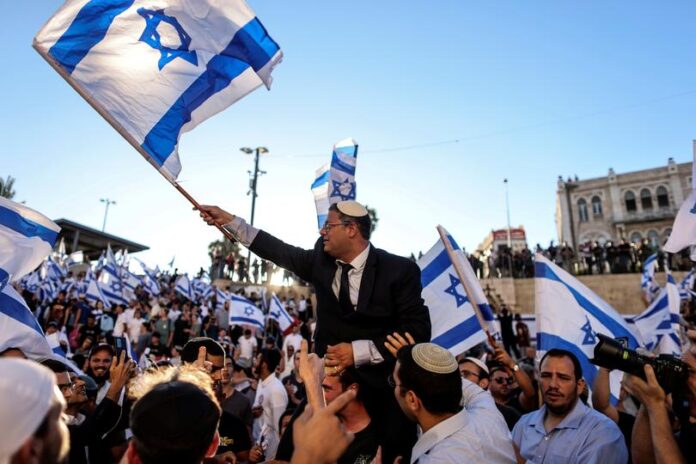JERUSALEM: Thousands of Israeli far-right nationalists marched in a flag-waving procession through East Jerusalem on Tuesday, an event that reignited tensions with Palestinians and posed an early challenge to Israel’s new government.
Last month, Israeli-Palestinian confrontations in contested Jerusalem helped trigger 11 days of cross-border fighting between Israel and Gaza’s ruling Hamas militant group.
On Tuesday, Israeli police in riot gear and on horseback cordoned off areas leading to the walled Old City’s flashpoint Damascus Gate, clearing the area to Palestinians before the marchers arrived.
Dancing and singing “the people of Israel live”, the crowd of mostly religious Jews, many carrying blue and white Israeli flags, filled the plaza in front of the gate, usually a popular social gathering spot for Palestinians.
“Take a good look at our flag. Live and suffer,” one marcher, a megaphone in one hand and a cigar in the other, shouted in Hebrew at Palestinian merchants on the other side of police barriers erected on an East Jerusalem street.
Israel, which occupied East Jerusalem in a 1967 war and later annexed it in a move that has not won international recognition, regards the entire city as its capital. Palestinians want East Jerusalem to be the capital of a future state that would include the West Bank and Gaza.
Sitting on a bench outside the police cordon, Khalil Mitwani, a 50-year-old Palestinian, said of the marchers: “They are making a big problem in Jerusalem. All the people here want peace – why make problems here?”
Hamas had warned of renewed hostilities over the march, testing the mettle of new Prime Minister Naftali Bennett’s administration of right-wing, centrist, left-wing and Arab parties and prompting Israel to beef up its deployment of the Iron Dome anti-missile system.
But as the marchers began to disperse after nightfall in Jerusalem, there was no sign of rocket fire from Gaza.
Several hours before the event started, however, Palestinians in Gaza launched incendiary balloons which the Israeli fire brigade said caused at least 20 blazes in fields in Israeli communities near the fenced border with the enclave.
Such incidents had stopped with the ceasefire that ended last month’s hostilities, in which Gaza militants unleashed rocket barrages into Israel and Israel pounded the small, densely populated coastal enclave with air strikes.
Israeli media reports said Bennett’s administration would order retaliation for the resumption of the balloon launches, though not necessarily immediately.
RE-ROUTING:
At least 27 Palestinians were injured in clashes in East Jerusalem with Israeli police firing stun grenades, the Palestine Red Crescent ambulance service said.
But the violence was not as extensive as many had feared.
In an apparent effort to avoid friction with Palestinians during the march, a police-charted route kept participants from going through the Damascus Gate, the main entry to the Muslim Quarter of the Old City and home to shrines sacred to Judaism, Islam and Christianity.
The marchers took a more peripheral route instead to Judaism’s sacred Western Wall, singing nationalist songs that echoed in alleyways where Palestinian merchants had shuttered their shops.
Yair Lapid, Bennett’s foreign minister and main partner in the governing coalition that ended Benjamin Netanyahu’s 12-year run as prime minister, condemned chants of “Death to the Arabs” from some of the marchers.
“That’s not Judaism, and that’s not being Israeli, and it is certainly not what our flag symbolises,” Lapid wrote on Twitter.
Tuesday’s march was originally scheduled for May 10 as part of “Jerusalem Day” festivities that celebrate Israel’s capture of East Jerusalem in the 1967 Middle East war.
At the last minute, that march was diverted away from the Damascus Gate and the Muslim Quarter, but the move was not enough to dissuade Hamas from firing rockets towards Jerusalem.























